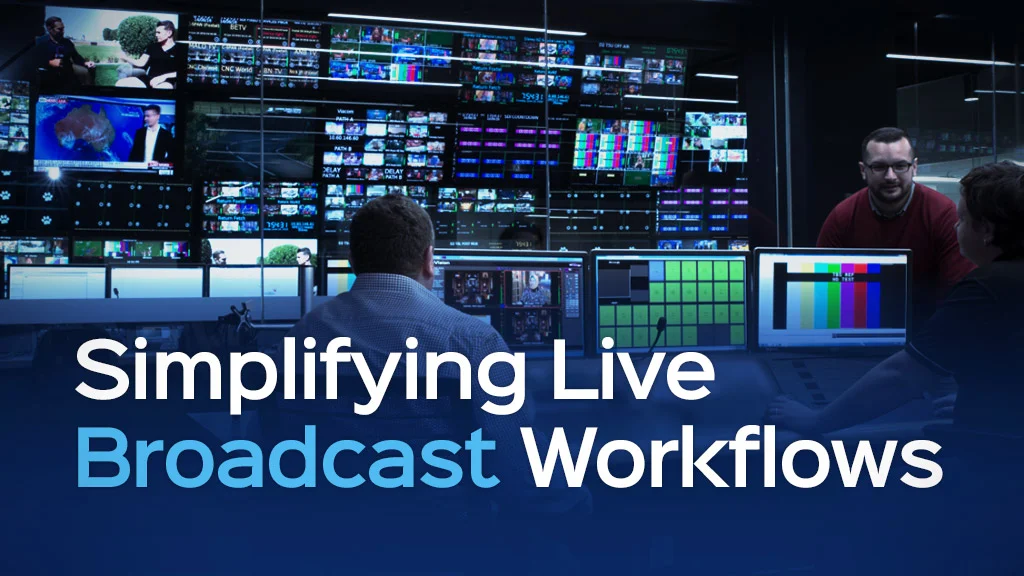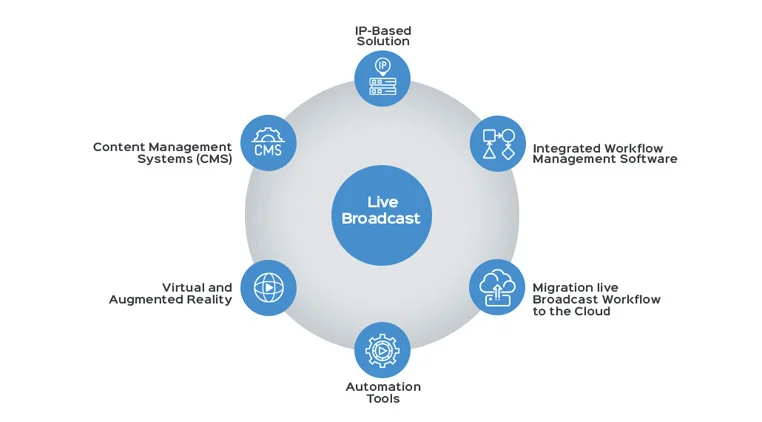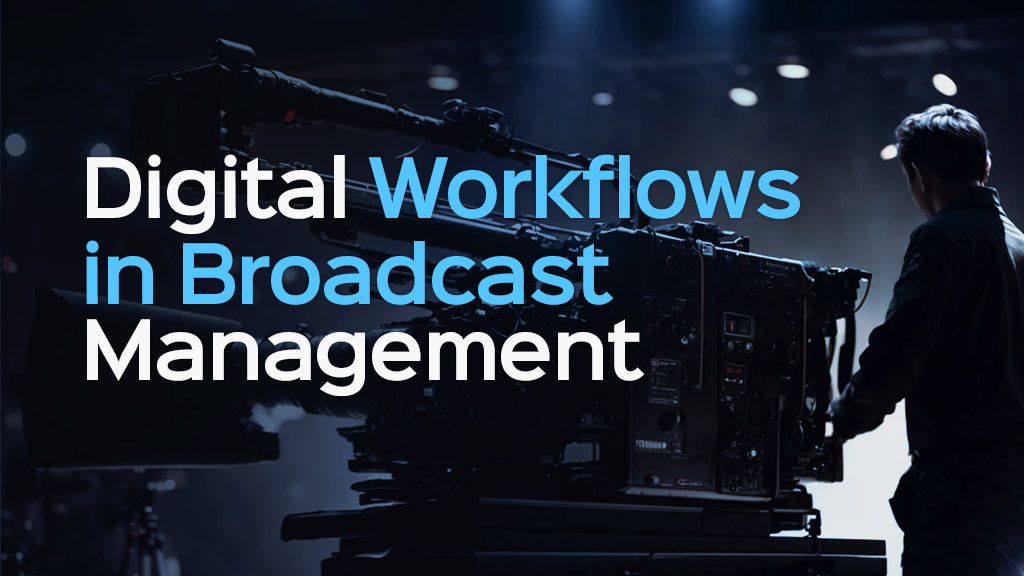
- Article
Guide to Simplifying Live broadcast Workflows
Live broadcasting encompasses a series of interconnected processes, from content creation to distribution and audience engagement. This guide emphasizes the importance of simplifying broadcast workflows to enhance quality and efficiency, while addressing challenges such as equipment compatibility, real-time decision-making and technical difficulties.
By leveraging advanced technologies such as IP-based solutions, automation, and cloud technology, broadcasters can streamline their processes and take advantage of automation benefits, including increased efficiency, consistency, and scalability.
Live broadcasting involves many integrated workflows that enable real-time transmission of audio and video content. These workflows include many procedures, from content creation and encoding to distribution and viewer engagement. Understanding the intricacies of the workflows is essential for broadcasters aiming to deliver high-quality live content efficiently and to optimize broadcast workflows for improved performance.

Major challenges in live broadcast Workflows
Live broadcasting presents several challenges, including:
Equipment Compatibility: In live broadcast workflows, ensuring compatibility between different devices is critical, given the variety of hardware and software available. Incompatibilities can lead to performance issues, signal loss, or even complete broadcast failures, requiring detailed planning and testing prior to the event.
Technical Difficulties: Live broadcasting is susceptible to a range of technical issues, including equipment malfunctions, connectivity problems, and power outages. These unexpected challenges require broadcasters to have contingency plans and backup systems in place to minimize disruptions.
Signal Quality and Latency: Maintaining high signal quality is critical for a successful broadcast. Factors such as network congestion, interference, and distance from transmission sources can all introduce latency or degrade signal quality, affecting the viewer experience.
Real-Time Decision-Making: Live broadcasts often require quick decision-making in response to unforeseen events, such as breaking news or technical difficulties. This rapid decision-making can be stressful and necessitates a well-coordinated team that is trained to handle high-pressure situations effectively.
Resource Management: Coordinating a live broadcast workflow typically involves extensive logistical planning, including managing personnel, equipment, and schedules. Efficient resource management is essential to ensure that all elements come together seamlessly on the day of the broadcast.
Regulatory Compliance: Broadcasters must navigate various legal and regulatory requirements, such as copyright laws and broadcasting licenses. Non-compliance can lead to significant legal issues and penalties, making it imperative to stay informed of applicable regulations.
Integration of New Technologies: As technology evolves, broadcasting tools and platforms also change. Broadcasters face the challenge of integrating emerging technologies — such as virtual reality, augmented reality, and artificial intelligence — without disrupting existing workflows.
Importance of Simplifying Broadcast Workflows
Simplifying broadcast workflows is not just about making processes easier; it is a strategic approach that leads to substantial benefits. By enhancing efficiency, quality, and collaboration, broadcasters can better meet viewer expectations and adapt to the ever-evolving media landscape. Streamlined processes allow teams to focus on content creation and audience engagement rather than getting bogged down by technical issues.

Leveraging Technologies to Simplify Workflows
1. IP-Based Solutions
Internet Protocol (IP) technology enables broadcasters to transmit audio and video content over standard internet networks, eliminating the need for traditional, dedicated broadcasting infrastructure. IP-based solutions facilitate seamless connectivity between different devices, allowing for easier integration of cameras, servers, and other equipment. This flexibility helps reduce complexity and enables a more agile broadcasting environment.
2. Automation Tools
Automation is a game-changer in live broadcasting. By automating repetitive tasks such as camera switching, graphics insertion, and audio mixing, broadcasters can minimize human error and free up staff to focus on creative aspects of the broadcast. Automation tools can also manage scheduling and alerts for technical checks, ensuring all systems are ready before going live.
3. Migration live Broadcast Workflow to the Cloud
Cloud technology simplifies workflows by providing broadcasters with scalable storage and processing capabilities. By utilizing the cloud, teams can collaborate remotely, access content from anywhere, and streamline the post-production process. Cloud technology also facilitates on-demand resource allocation, allowing broadcasters to adjust their capabilities based on the event’s size and complexity.
4. Content Management Systems (CMS)
A robust CMS allows broadcasters to organize, store, and retrieve content efficiently. With an effective CMS, teams can manage media assets, track metadata, and streamline the editing process, reducing the time spent searching for files and improving workflow efficiency.
5. Real-Time Analytics
Implementing real-time analytics tools can significantly enhance decision-making during live broadcasts. By gaining insights into viewer engagement and technical performance, broadcasters can make immediate adjustments to improve the viewer experience. This technology supports quick feedback loops, enabling teams to respond dynamically to audience needs.
6. Virtual and Augmented Reality
These emerging technologies can be integrated into live broadcasts to create immersive viewer experiences. By incorporating VR and AR elements, broadcasters can enhance storytelling and viewer engagement, making the content more appealing and interactive.
7. Integrated Workflow Management Software
Comprehensive workflow management software can help streamline the entire broadcasting process, from pre-production planning to post-broadcast analysis. By integrating various components and tracking progress in real-time, these solutions enhance visibility and coordination across the team.
Read also :
Key Benefits of Automation in Live broadcast Workflows
Automation has become an essential element in modern live broadcasting, offering numerous advantages that enhance efficiency, quality, and overall production value. Here are the key benefits of integrating automation into live broadcast workflows:
1. Increased Efficiency
Automation streamlines repetitive tasks, such as camera switching significantly reducing the time and effort required by the production team. This allows staff to focus on higher-level decision-making and creative processes, resulting in a more efficient broadcast operation.
2. Consistency and Accuracy
Automated systems perform tasks with precision and reliability, minimizing the risk of human errors. This consistency ensures that broadcasts maintain high quality throughout the production process, whether it’s in camera movements, audio levels, or visual graphics displayed on screen.
3. Real-Time Adjustments
in live broadcast Workflows, Automation enables real-time adjustments. For example, automated systems can be programmed to respond to audio levels or signal changes, allowing for immediate corrections without manual intervention. This responsiveness can prevent interruptions and enhance the viewing experience.
4. Scalability
Automated workflows are inherently more scalable. As a broadcast operation expands or as demand increases for larger events, automation tools can easily adapt without needing a proportionate increase in staffing. This flexibility allows broadcasters to efficiently handle everything from small productions to large-scale events.
5. Simplified Workflows
Automation simplifies complex workflows by establishing streamlined processes that minimize the number of manual interventions required. This simplification reduces training needs and accelerates onboarding for new staff, making the broadcast operation more adaptable.
6. Reliability and Stability
Automated systems enhance the reliability of live broadcasts by providing consistent performance levels. With reduced manual inputs, the likelihood of technical errors due to human oversight is diminished, resulting in a more stable production.
7. Integration with Other Technologies
Automation easily integrates with other broadcast technologies (e.g., IP-based solutions, cloud services), allowing for smooth transitions and collaborations between different systems. This synergy further enhances the efficiency of broadcast workflows.
Simplify Broadcast workflow with Samim Solutions
Samim Group provides innovative tools and services designed to simplify live broadcast workflows. Samim’s products, including Audio Video Signal Routers, SDI Video Processors, and Video Router Multiviewers, enable effective signal management, allowing operators in TV production control room to effortlessly combine and monitor audio and video signals.
By integrating advanced technology, Samim Solutions helps broadcasters streamline their processes, improve compatibility among devices, and enhance overall broadcast quality. Additionally, Samim’s solutions include robust media asset management capabilities and automation, which empower teams to efficiently organize and access content. With these tailored solutions, broadcasters can focus on delivering engaging content while minimizing technical challenges.
Contact us right now
If you prefer to speak directly to our sales or support teams, do not hesitate to get in touch with us right now.
or, Let us contact you at a later time
If you prefer us to contact you as soon as possible and discuss your specific requirements, please fill out the following form.
"*" indicates required fields









